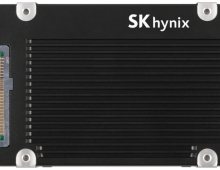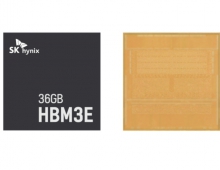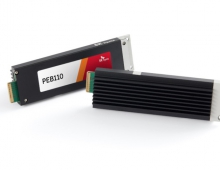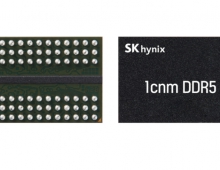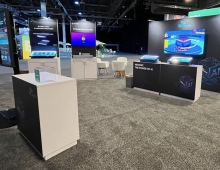
Elpida Completes Development of 2-Gigabit GDDR5
Elpida Memory, Japan's leading global supplier of Dynamic Random Access Memory (DRAM), today announced that it had completed development of a high-density, high-speed, 50nm process 2-gigabit GDDR5 using copper interconnects (product name: EDW2032BABG).
The new GDDR5, the first graphics DRAM designed by Elpida,
was developed at the company's Munich Design Center in
Germany.
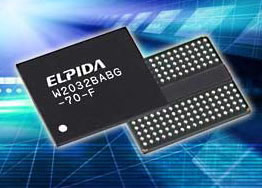 Applications for GDDR (GDDR: Graphics Double
Data Rate) memory devices used with GPU (Graphics
Processing Unit) are found not only in such graphic
processing equipment as game consoles and PC graphics cards
but also in equipment that require high-performance
computing for use in such areas as science and technology,
physical simulation, digital image processing and video
conversion. Using 2-gigabit GDDR5 in these applications can
double the frame buffer size of each GPU compared with
1-gigabit memory products.
Applications for GDDR (GDDR: Graphics Double
Data Rate) memory devices used with GPU (Graphics
Processing Unit) are found not only in such graphic
processing equipment as game consoles and PC graphics cards
but also in equipment that require high-performance
computing for use in such areas as science and technology,
physical simulation, digital image processing and video
conversion. Using 2-gigabit GDDR5 in these applications can
double the frame buffer size of each GPU compared with
1-gigabit memory products.
As a result, the GPU can perform high-speed processing without exchanging large-volume image data with the main memory, making possible realistic PC graphics images. Also, use of 2-gigabit GDDR5 in such fields as science & technology computing and physical simulations is expected to improve system performance, as systems installed with the new graphics DRAM can handle larger amounts of data and more thread processing.
At present, Elpida is outsourcing 1-gigabit GDDR3/GDDR5 production to Taiwan-based Winbond Electronics Corporation. The company's Hiroshima Plant, however, plans to handle 2-gigabit GDDR5 production. Basing this production in Hiroshima enables Elpida to provide a more timely and flexible response to anticipated future growth in graphics DRAM demand.
Elpida plans to begin sample shipments of the new 2-gigabit GDDR5 in July 2010. Mass production is expected to get underway in the CY 2010 third quarter (July-Sept).
2-gigabit GDDR5 Overview
Product name: EDW2032BABG
Memory density: 2-gigabit
Speed: 7Gbps (max.)
Configuration: 64-megabit x32, 8-bank
Special features:
- Two I/O configurations ?x32 and x16
- To save mass manufacturing testing costs Elpida's proprietary test method is used, making an ultra-high speed tester unnecessary
 Applications for GDDR (GDDR: Graphics Double
Data Rate) memory devices used with GPU (Graphics
Processing Unit) are found not only in such graphic
processing equipment as game consoles and PC graphics cards
but also in equipment that require high-performance
computing for use in such areas as science and technology,
physical simulation, digital image processing and video
conversion. Using 2-gigabit GDDR5 in these applications can
double the frame buffer size of each GPU compared with
1-gigabit memory products.
Applications for GDDR (GDDR: Graphics Double
Data Rate) memory devices used with GPU (Graphics
Processing Unit) are found not only in such graphic
processing equipment as game consoles and PC graphics cards
but also in equipment that require high-performance
computing for use in such areas as science and technology,
physical simulation, digital image processing and video
conversion. Using 2-gigabit GDDR5 in these applications can
double the frame buffer size of each GPU compared with
1-gigabit memory products.
As a result, the GPU can perform high-speed processing without exchanging large-volume image data with the main memory, making possible realistic PC graphics images. Also, use of 2-gigabit GDDR5 in such fields as science & technology computing and physical simulations is expected to improve system performance, as systems installed with the new graphics DRAM can handle larger amounts of data and more thread processing.
At present, Elpida is outsourcing 1-gigabit GDDR3/GDDR5 production to Taiwan-based Winbond Electronics Corporation. The company's Hiroshima Plant, however, plans to handle 2-gigabit GDDR5 production. Basing this production in Hiroshima enables Elpida to provide a more timely and flexible response to anticipated future growth in graphics DRAM demand.
Elpida plans to begin sample shipments of the new 2-gigabit GDDR5 in July 2010. Mass production is expected to get underway in the CY 2010 third quarter (July-Sept).
2-gigabit GDDR5 Overview
Product name: EDW2032BABG
Memory density: 2-gigabit
Speed: 7Gbps (max.)
Configuration: 64-megabit x32, 8-bank
Special features:
- Two I/O configurations ?x32 and x16
- To save mass manufacturing testing costs Elpida's proprietary test method is used, making an ultra-high speed tester unnecessary

